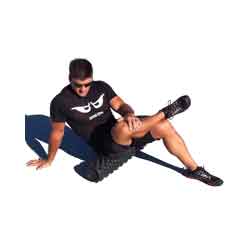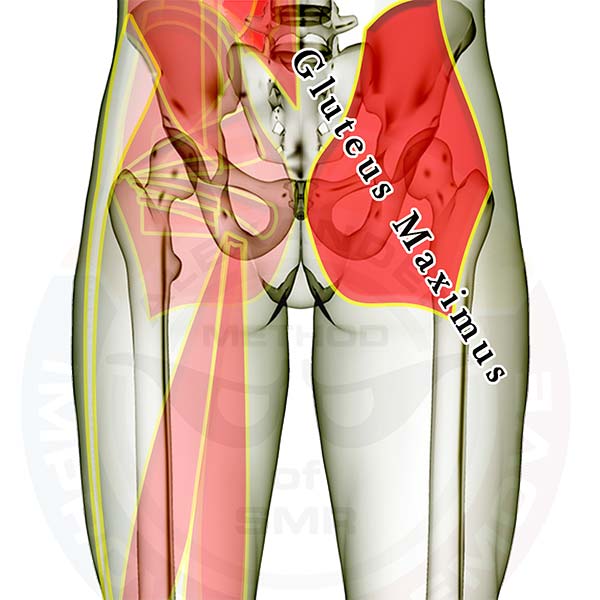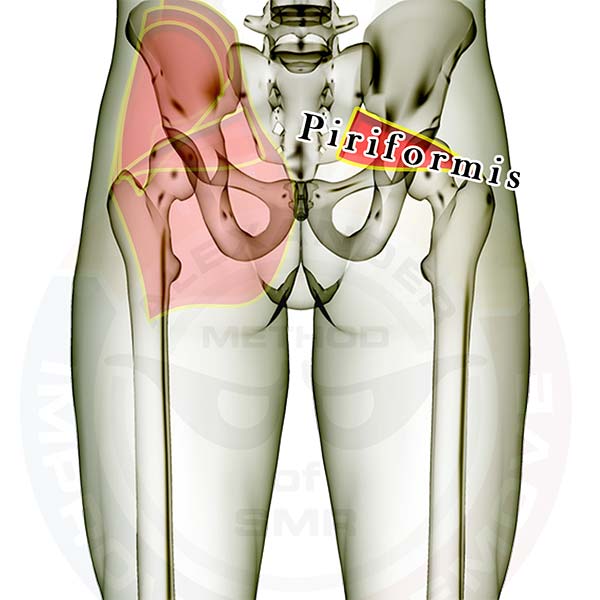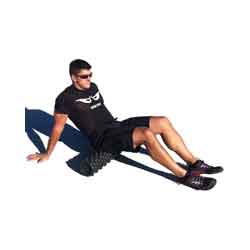 This SMR exercise is a variation of the Piriformis Press technique to address the lateral rotators of the hip. You may find this exercise easier. If the Piriformis Press is too intense to work with, then practice the Piriformis Roll to more gently work out the "junk" in your buns. It may take a month or two to help your muscles along to become healthy enough to handle the Secondary technique (which is the preferred standard SMR technique for the piriformis). You probably won't notice knots in your buns when you are just walking around, but you may have a deep ache in one or more of the other muscles "back there." The gluteus maximus (and the other posterior hip muscles) is involved in any movement using the hips. When parts of it lock up, proper hip function is compromised. You will notice a 'lightness' with body movements if you release any knots in your glutes. |
|
For written instructions, click here to download a printable PDF of the Piriformis Roll Be sure to post your questions and comments below. We want to provide the best instruction to help you recover from your workouts. Click here to return to all of the Fundamental SMR Techniques **All information is provided for educational purposes only. You should consult your doctor before attempting any exercises you read on this page or any page on this website.** |
Tag: Sciatica Issues
Gluteus Maximus

Pictured above is the gluteus maximus muscle. It primarily works to extend (open) the hip. It is rare that this muscle will need SMR attention, but regular stretching is strongly suggested for the glutes and the hamstrings.
The muscles are layered, showing how some of the muscles are covered by the others. All of the muscles are see-through so that you can appreciate the location and size of each muscle relative to the others. You can access individual muscle detail for all the other muscles in the body with our Coach membership.
Individual hip, lower back & thigh muscles you might be interested in: (any inactive links will be live soon)
Click here for a list of all the muscles.
Muscle that crosses the hip/lower back joint and crosses the hip/thigh joint (attaches to the spine and the femur)
Muscles that attach to the hip and the spine and/or ribs
- Rectus Abdominus
- External Abdominal Oblique
- Internal Abdominal Oblique
- Transverse Abdominus
- Latissimus Dorsi
- Iliocostalis Lumborum
- Longissimus Thoracis
- Quadratus Lumborum
- Multifidi
Muscles that attach to the hip and the thigh bone (femur)
- Iliacus
- Rectus Femoris
- Tensor Fasciae Latae
- Sartorius
- Gracilis
- Adductor Magnus
- Adductor Longus
- Adductor Brevis
- Pectineus
- Gluteus Maximus
- Gluteus Medius
- Gluteus Minimus
- Piriformis
- Superior Gemellus
- Obturator Internus
- Inferior Gemellus
- Obturator Externus
- Quadratus Femoris
- Biceps Femoris
- Semitendonosis
- Semimembranosis
Good luck working out those tight knots.
If you have any questions, please post a comment. We try to respond within 24 hours.
We're here to help you get more out of your training!
Piriformis

Pictured above is the piriformis. It is one of the lateral rotator muscles of the hip, and rotates your leg so that your toes point outward. Because of the location of this muscle in relation to the sciatic nerve, releasing excessive tension in this muscle can dramatically improve sciatica symptoms. (click here for a list of all the muscles)
The muscles on the left are layered, showing how some of the muscles are covered by the others. All of the muscles are see-through so that you can appreciate the location and size of each muscle relative to the others.
Individual hip, lower back & thigh muscles you might be interested in: (any inactive links will be live soon)
Muscle that crosses the hip/lower back joint and crosses the hip/thigh joint (attaches to the spine and the femur)
Muscles that attach to the hip and the spine and/or ribs
- Rectus Abdominus
- External Abdominal Oblique
- Internal Abdominal Oblique
- Transverse Abdominus
- Latissimus Dorsi
- Iliocostalis Lumborum
- Longissimus Thoracis
- Quadratus Lumborum
- Multifidi
Muscles that attach to the hip and the thigh bone (femur)
- Iliacus
- Adductor Magnus
- Adductor Longus
- Adductor Brevis
- Pectineus
- Gluteus Maximus
- Gluteus Medius
- Gluteus Minimus
- Piriformis
- Superior Gemellus
- Obturator Internus
- Inferior Gemellus
- Obturator Externus
- Quadratus Femoris
Good luck working out those tight knots.
If you have any questions, please post a comment. We try to respond within 24 hours.
We're here to help you get more out of your training!
Glutes Roll
 You probably won't notice knots in your buns when you are just walking around, but when you slowly roll through this tissue, you'll find them! The gluteus maximus (and many of the other posterior hip muscles) is involved in any movement using the hips. When one or more of your glutes is dysfunctional, proper hip function is compromised. You will notice a 'lightness' with body movements if you release any knots in your glutes. |
|
For written instructions, click here to download a printable PDF of the Glutes Roll For our downloadable video instruction, click here. (video from 2010--updated video is in the works!) If you have lower back issues you should begin this technique by lying flat on the floor FIRST, then lift your hips to get the roller underneath you (instead of sitting on the roller and lying back). Be sure to post your questions and comments below. We want to provide the best instruction to help you recover from your workouts. Click here to return to all of the Fundamental SMR Techniques **All information is provided for educational purposes only. You should consult your doctor before attempting any exercises you read on this page or any page on this website.** |
